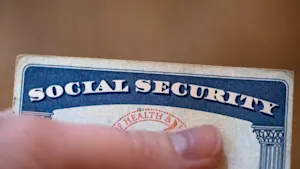Millennial Money: 4 items for your midyear money checklist
A lot can happen in six months. That’s why, as we close out the first half of the year, it makes sense to check in on your financial life.
Share:
More Stories
2:01

No progress: Frustrated Rockland businesses want more from lawmakers as pipeline project rankles revenue
4ds ago2:14

Tarrytown's Connor McGinn Studios shakes things up for the spooky season with 'The Creepshow'
5ds ago0:34

Amazon cuts 14,000 corporate jobs as spending on artificial intelligence accelerates
5ds ago1:46

The Cost Of: Halloween decorations & parties
6ds ago1:46

The Cost Of: Spooky season spending up for decorations and Halloween parties
6ds ago0:26

Social Security recipients get 2.8% cost-of-living boost in 2026, average of $56 per month
9ds ago2:01

No progress: Frustrated Rockland businesses want more from lawmakers as pipeline project rankles revenue
4ds ago2:14

Tarrytown's Connor McGinn Studios shakes things up for the spooky season with 'The Creepshow'
5ds ago0:34

Amazon cuts 14,000 corporate jobs as spending on artificial intelligence accelerates
5ds ago1:46

The Cost Of: Halloween decorations & parties
6ds ago1:46

The Cost Of: Spooky season spending up for decorations and Halloween parties
6ds ago0:26

Social Security recipients get 2.8% cost-of-living boost in 2026, average of $56 per month
9ds ago
A lot can happen in six months. That’s why, as we close out the first half of the year, it makes sense to check in on your financial life.
“With inflation, I think people this year are more heavily impacted than they probably have been in many years leading up to this point,” says Jason Dall’Acqua, a certified financial planner and founder of Crest Wealth Advisors in Annapolis, Maryland. “So it’s a good time to see how things have been going ... as well as plan for what lies ahead in the remainder of the year.”
So where should you start? Add these four items to your midyear money checklist.
1. REVIEW YOUR INCOME, EXPENSES AND GOALS
You don’t have to tally up every penny you’ve made and spent over the last six months. But taking a few minutes to check a bank or budget app can help you better understand your finances and course-correct if necessary.
“Right now with inflation, even if you had a budget back in January, it probably is not the same as it is today. There are some things that are going to need to be changed. So it’s just really resetting and figuring out where you stand today versus where you thought you were going to stand today,” says Kayla Welte, a CFP with District Capital Management who lives in Denver.
Look for opportunities to scale back if you’ve spent more than anticipated. For example, you can dine out less or cancel subscription services you rarely use. “Any excess spending that you’ve been doing, you may have to cut down to account for this higher cost of things that you absolutely have to buy,” Welte says.
If you set money resolutions or other financial goals earlier this year, check on those too. Have you saved as much toward retirement or an emergency fund as you planned? Are you on track to pay off debt?
2. DEAL WITH DEBT
Debt is becoming more expensive to carry due to rising interest rates. Pay down debts sooner, particularly those with variable interest rates, to save money. These debts might include credit cards, personal loans or adjustable-rate mortgages.
Concentrate on reducing your highest-rate debt first, then move on to the next highest. Dall’Acqua also suggests switching from variable-rate to fixed-rate options by refinancing, if possible. “If you can lock in the fixed rate now, you’re likely to be saving yourself significantly in interest costs over time,” he says.
Be aware of end dates for loans in forbearance. For instance, federal student loan payments will resume on Sept. 1, barring another extension.
“At this point they have been on pause for nearly two years,” Dall’Acqua says. “So if that money has gotten lost within (people’s) overall spending, it’s going to be a big shock when they then have to resume paying.”
Setting aside money now in a separate savings fund can help soften the blow.
3. PLAN HOLIDAY SHOPPING
Inflation could make holiday gifts a little pricier this year. Create a shopping list and think about how much you can afford to spend. “Figure out what that would require for you to start saving on a weekly or monthly basis and start putting that money aside right now,” Dall’Acqua says.
Starting on shopping early can also help you manage the cost without accruing debt. Many retailers host major sale events in the summer, so you’ll find discounts well before Black Friday. Amazon’s Prime Day is coming in July. So is the Nordstrom Anniversary Sale.
4. EXAMINE YOUR TAXES AND BENEFITS
Welte recommends using an online tax calculator to check whether you’re withholding too much or too little. This can help you avoid getting hit with a big tax bill unexpectedly or missing out on extra cash you may need now.
“If you do the math and you’re going to get a $6,000 tax refund, it would be a great time to change your W-4s, get more money in your pocket now to pay for these excess costs that are coming up with inflation rather than waiting until next April to get that refund,” Welte says.
If you need to make adjustments, fill out a new Form W-4 (you can find this on the IRS website) and submit it to your employer.
While you’re at it, evaluate your employee benefit selections. These benefits can include health insurance, life insurance, health savings accounts and flexible spending accounts, plus perks like gym memberships.
Reviewing your choices in the summer can prevent you from becoming overwhelmed in October and November, when open enrollment begins for most companies, says Joe Bautista, a CFP in Lake Oswego, Oregon.
The goal is to ensure you’re choosing the most cost-effective options that suit your needs. For example, “a PPO has higher premiums but a lower cost if you tend to use health care, lower deductibles and copays typically. But if someone doesn’t use that health care, then they can be overspending,” Bautista says.
Don’t worry about getting everything perfect right now. As Bautista says, “financial planning is dynamic, it’s not static.” Check in on your money plans periodically and update as needed.
________________________________
This column was provided to The Associated Press by the personal finance website NerdWallet. Lauren Schwahn is a writer at NerdWallet. Email: lschwahn@nerdwallet.com. Twitter: @lauren_schwahn.
More from News 12
0:31

Unlicensed DWI suspect crashes into Ramapo police vehicle
2:06

Sunny day for the Hudson Valley; tracking cold temperatures in the week ahead
0:19

5 residents displaced when tree falls on Hyde Park home
1:54

Yankee Ferry, the last Ellis Island passenger boat, is for sale. Here's a look at its rich history
0:42

Free meals available for Peekskill SNAP residents amid government shutdown
1:31
